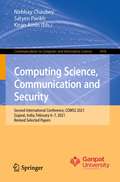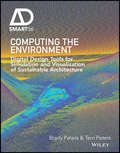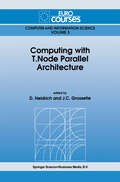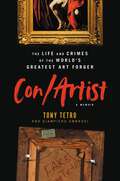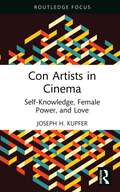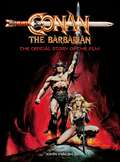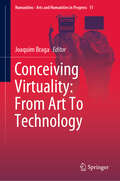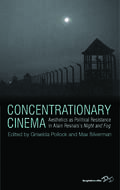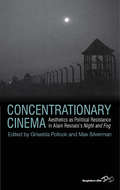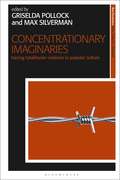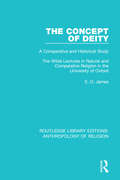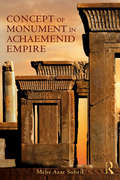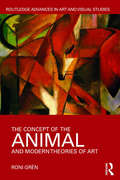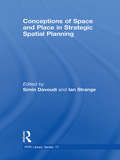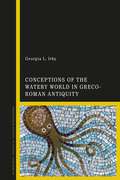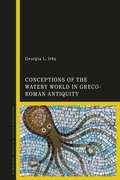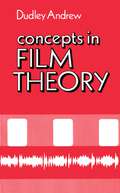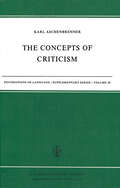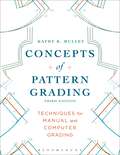- Table View
- List View
Computing Science, Communication and Security: Second International Conference, COMS2 2021, Gujarat, India, February 6–7, 2021, Revised Selected Papers (Communications in Computer and Information Science #1416)
by Nirbhay Chaubey Satyen Parikh Kiran AminThis book constitutes revised selected papers of the Second International Conference on Computing Science, Communication and Security, COMS2 2021, held in Gandhinagar, India, in February 2021. Due to the COVID-19 pandemic the conference was held virtually. The 19 full papers were thoroughly reveiwed and selected from 105 submissions. Papers are organised according to the topical sections on artificial intelligence and machine learning; networking and communications.
Computing the Environment: Digital Design Tools for Simulation and Visualisation of Sustainable Architecture (AD Smart)
by Brady Peters Terri PetersComputing the Environment presents practical workflows and guidance for designers to get feedback on their design using digital design tools on environmental performance. Starting with an extensive state-of-the-art survey of what top international offices are currently using in their design projects, this book presents detailed descriptions of the tools, algorithms, and workflows used and discusses the theories that underlie these methods. Project examples from Transsolar Klimaengineering, Buro Happold´s SMART Group, Behnish Behnisch Architects, Thomas Herzog, Autodesk Research are contextualized with quotes and references to key thinkers in this field such as Eric Winsberg, Andrew Marsh, Michelle Addington and Ali Malkawi.
Computing the Environment: Digital Design Tools for Simulation and Visualisation of Sustainable Architecture (AD Smart)
by Brady Peters Terri PetersComputing the Environment presents practical workflows and guidance for designers to get feedback on their design using digital design tools on environmental performance. Starting with an extensive state-of-the-art survey of what top international offices are currently using in their design projects, this book presents detailed descriptions of the tools, algorithms, and workflows used and discusses the theories that underlie these methods. Project examples from Transsolar Klimaengineering, Buro Happold´s SMART Group, Behnish Behnisch Architects, Thomas Herzog, Autodesk Research are contextualized with quotes and references to key thinkers in this field such as Eric Winsberg, Andrew Marsh, Michelle Addington and Ali Malkawi.
Computing with T.Node Parallel Architecture (Eurocourses: Computer and Information Science #3)
by D. Heidrich J. C. GrossetieParallel processing is seen today as the means to improve the power of computing facilities by breaking the Von Neumann bottleneck of conventional sequential computer architectures. By defining appropriate parallel computation models definite advantages can be obtained. Parallel processing is the center of the research in Europe in the field of Information Processing Systems so the CEC has funded the ESPRIT Supemode project to develop a low cost, high performance, multiprocessor machine. The result of this project is a modular, reconfigurable architecture based on !NMOS transputers: T.Node. This machine can be considered as a research, industrial and commercial success. The CEC has decided to continue to encourage manufacturers as well as research and end-users of transputers by funding other projects in this field. This book presents course papers of the Eurocourse given at the Joint Research Centre in ISPRA (Italy) from the 4th to 8 of November 1991. First we present an overview of various trends in the design of parallel architectures and specially of the T.Node with it's software development environments, new distributed system aspects and also new hardware extensions based on the !NMOS T9000 processor. In a second part, we review some real case applications in the field of image synthesis, image processing, signal processing, terrain modeling, particle physics simulation and also enhanced parallel and distributed numerical methods on T.Node.
Con/Artist: The Life and Crimes of the World's Greatest Art Forger
by Tony Tetro Giampiero AmbrosiThe world&’s most renowned art forger reveals the secrets behind his decades of painting like the masters—exposing an art world that is far more corrupt than we ever knew while providing an art history lesson wrapped in sex, drugs, and Caravaggio. The art world is a much dirtier, nastier business than you might expect. Tony Tetro, one of the most renowned art forgers in history, will make you question every masterpiece you&’ve ever seen in a museum, gallery, or private collection. Tetro&’s &“Rembrandts,&” &“Caravaggios,&” &“Miros,&” and hundreds of other works now hang on walls around the globe. In 2019, it was revealed that Prince Charles received into his collection a Picasso, Dali, Monet, and Chagall, insuring them for over 200 million pounds, only to later discover that they&’re actually &“Tetros.&” And the kicker? In Tony&’s words: &“Even if some tycoon finds out his Rembrandt is a fake, what&’s he going to do, turn it in? Now his Rembrandt just became motel art. Better to keep quiet and pass it on to the next guy. It&’s the way things work for guys like me.&” The Prince Charles scandal is the subject of a forthcoming feature documentary with Academy Award nominee Kief Davidson and coauthor Giampiero Ambrosi, in cooperation with Tetro. Throughout Tetro&’s career, his inimitable talent has been coupled with a reckless penchant for drugs, fast cars, and sleeping with other con artists. He was busted in 1989 and spent four years in court and one in prison. His voice—rough, wry, deeply authentic—is nothing like the high society he swanned around in, driving his Lamborghini or Ferrari, hobnobbing with aristocrats by day, and diving into debauchery when the lights went out. He&’s a former furniture store clerk who can walk around in Caravaggio&’s shoes, become Picasso or Monet, with an encyclopedic understanding of their paint, their canvases, their vision. For years, he hid it all in an unassuming California townhouse with a secret art room behind a full-length mirror. (Press #* on his phone and the mirror pops open.) Pairing up with coauthor Ambrosi, one of the investigative journalists who uncovered the 2019 scandal, Tetro unveils the art world in an epic, alluring, at times unbelievable, but all-true narrative.
Con Artists in Cinema: Self-Knowledge, Female Power, and Love (Routledge Focus on Film Studies)
by Joseph H. KupferThis book examines the con artist film as a genre, exploring its main features while also addressing variations within it. The volume explores three diverse themes of the con artist film: edification, self-awareness, and liberation through con games; the femme fatale as con artist; and romantic love as a plot point. Analyzing movies such as Matchstick Men (2003), House of Games (1987), Body Heat (1981), The Last Seduction (1994), Birthday Girl (2001), and The Game (1997), the book also explores their psychological investigation of the con artist figure, the con artist’s mark, and how the dynamic between these roles implicates us as the audience. It also addresses the con artist film genre’s close association with neo-noir, especially through the femme fatale figure, investigating and updating the rich tradition of noir film. Demonstrating the range and flexibility of this understudied genre, this book will be of interest to scholars and students of film studies, ethics, and those studying the representation of women in film..
Con Artists in Cinema: Self-Knowledge, Female Power, and Love (Routledge Focus on Film Studies)
by Joseph H. KupferThis book examines the con artist film as a genre, exploring its main features while also addressing variations within it. The volume explores three diverse themes of the con artist film: edification, self-awareness, and liberation through con games; the femme fatale as con artist; and romantic love as a plot point. Analyzing movies such as Matchstick Men (2003), House of Games (1987), Body Heat (1981), The Last Seduction (1994), Birthday Girl (2001), and The Game (1997), the book also explores their psychological investigation of the con artist figure, the con artist’s mark, and how the dynamic between these roles implicates us as the audience. It also addresses the con artist film genre’s close association with neo-noir, especially through the femme fatale figure, investigating and updating the rich tradition of noir film. Demonstrating the range and flexibility of this understudied genre, this book will be of interest to scholars and students of film studies, ethics, and those studying the representation of women in film..
Conan the Barbarian: The Official Story of the Film
by John WalshIn 1982, Robert E. Howard's iconic literary anti-hero, Conan, slashed his way from page to screen after a perilous decades-long journey. With its potent mix of epic vistas and bloody battles, Conan the Barbarian thrilled moviegoers around the world and launched the career of Arnold Schwarzenegger. Forty years after its release, this cult-classic film is celebrated in Conan the Barbarian – The Official Story of the Film, a lush hardback volume that tells the full story of how the film was made. Brand new interviews with cast and crew, as well behind-the-scenes photography from the set and concept art created for the production, give fascinating insights into the development of one of the best-loved fantasy films of the 1980s.
Conceiving Virtuality: From Art To Technology (Numanities - Arts and Humanities in Progress #11)
by Joaquim BragaThis book provides new theoretical approaches to the subject of virtuality. All chapters reflect the importance of extending the analysis of the concept of “the virtual” to areas of knowledge that, until today, have not been fully included in its philosophical foundations. The respective chapters share new insights on art, media, psychic systems and technology, while also presenting new ways of articulating the concept of the virtual with regard to the main premises of Western thought. Given its thematic scope, this book is intended not only for a philosophical audience, but also for all scientists who have turned to the humanities in search of answers to their questions.
Concentrationary Cinema: Aesthetics as Political Resistance in Alain Resnais's <I>Night and Fog</I>
by Griselda Pollock Max SilvermanSince its completion in 1955, Alain Resnais’s Night and Fog (Nuit et Brouillard) has been considered one of the most important films to confront the catastrophe and atrocities of the Nazi era. But was it a film about the Holocaust that failed to recognize the racist genocide? Or was the film not about the Holocaust as we know it today but a political and aesthetic response to what David Rousset, the French political prisoner from Buchenwald, identified on his return in 1945 as the ‘concentrationary universe’ which, now actualized, might release its totalitarian plague any time and anywhere? What kind of memory does the film create to warn us of the continued presence of this concentrationary universe? This international collection re-examines Resnais’s benchmark film in terms of both its political and historical context of representation of the camps and of other instances of the concentrationary in contemporary cinema. Through a range of critical readings, Concentrationary Cinema explores the cinematic aesthetics of political resistance not to the Holocaust as such but to the political novelty of absolute power represented by the concentrationary system and its assault on the human condition.
Concentrationary Cinema: Aesthetics as Political Resistance in Alain Resnais's <I>Night and Fog</I>
by Griselda Pollock Max SilvermanSince its completion in 1955, Alain Resnais’s Night and Fog (Nuit et Brouillard) has been considered one of the most important films to confront the catastrophe and atrocities of the Nazi era. But was it a film about the Holocaust that failed to recognize the racist genocide? Or was the film not about the Holocaust as we know it today but a political and aesthetic response to what David Rousset, the French political prisoner from Buchenwald, identified on his return in 1945 as the ‘concentrationary universe’ which, now actualized, might release its totalitarian plague any time and anywhere? What kind of memory does the film create to warn us of the continued presence of this concentrationary universe? This international collection re-examines Resnais’s benchmark film in terms of both its political and historical context of representation of the camps and of other instances of the concentrationary in contemporary cinema. Through a range of critical readings, Concentrationary Cinema explores the cinematic aesthetics of political resistance not to the Holocaust as such but to the political novelty of absolute power represented by the concentrationary system and its assault on the human condition.
Concentrationary Imaginaries: Tracing Totalitarian Violence in Popular Culture (New Encounters: Arts, Cultures, Concepts)
by Griselda Pollock Max SilvermanWhat defines 'quality' in contemporary Hollywood film? Although often seen as inhospitable to such work, the studios of the blockbuster-franchise era continue to produce features that make claims to higher status. Films such as The Social Network, The Assassination of Jesse James by the Coward Robert Ford and Mystic River are marked as distinctive from the mainstream norm. But how exactly, and how are such qualities mixed with more familiar Hollywood ingredients, as found in larger doses in other examples such as Blood Diamond and the blockbuster-scale Inception?Quality Hollywood is the first book to address these issues, featuring close analysis of case study films, critical responses and the wider notions of cultural value on which these draw. Geoff King argues that such films retain a presence as a minority strand of studio output. The reasons for this combine factors relating to economics, the power of certain filmmakers and Hollywood's investment in its own prestige.
The Concept of Deity: A Comparative and Historical Study. The Wilde Lectures in Natural and Comparative Religion in the University of Oxford (Routledge Library Editions: Anthropology of Religion #2)
by E.O. JamesFor good or ill, most, if not all, of the great institutions which have formed the framework of society have had their roots in the idea of Deity as a beneficent providential order of transcendental reality. In being handed down through countless generations the beliefs, concepts and customs have assumed a great variety of new outward forms in the process of transmission and development. To determine their true meaning and function as a cohesive force and as an expression of ultimate reality, the comparative and historical methods can be employed with considerable advantage. This book, first published in 1950, provides a valuable comparative study of religion.
The Concept of Deity: A Comparative and Historical Study. The Wilde Lectures in Natural and Comparative Religion in the University of Oxford (Routledge Library Editions: Anthropology of Religion #2)
by E.O. JamesFor good or ill, most, if not all, of the great institutions which have formed the framework of society have had their roots in the idea of Deity as a beneficent providential order of transcendental reality. In being handed down through countless generations the beliefs, concepts and customs have assumed a great variety of new outward forms in the process of transmission and development. To determine their true meaning and function as a cohesive force and as an expression of ultimate reality, the comparative and historical methods can be employed with considerable advantage. This book, first published in 1950, provides a valuable comparative study of religion.
The Concept of Monument in Achaemenid Empire
by Mehr Azar SoheilThe aim of this book is to explore the significance of the concept of ‘monument’ in the context of the Achaemenid Empire (550-330 BC), with particular reference to the Royal Ensemble of Persepolis, founded by Darius I and built together with his son Xerxes. While Persepolis was built as an ‘intentional monument’, it had already become an ‘historic monument’ during the Achaemenid period. It maintained its symbolic significance in the following centuries even after its destruction by Alexander of Macedonia in 330 BC. The purpose of building Persepolis was to establish a symbol and a common reference for the peoples of the Empire with the Achaemenid Dynasty, transmitting significant messages and values such as peace, stability, grandeur and praise for the dynastic figure of the king as the protector of values and fighting falsehood. While previous research on Achaemenid heritage has mainly been on archaeological and art-historical aspects of Persepolis, the present work focuses on the architecture and design of Persepolis. It is supported by studies in the fields of archaeology, history and art history, as well as by direct survey of the site. The morphological analysis of Persepolis, including the study of the proportions of the elevations, and the verification of a planning grid for the layout of the entire ensemble demonstrate the univocal will by Darius to plan Persepolis following a precise initial scheme. The study shows how the inscriptions, bas-reliefs and the innovative architectural language together express the symbolism, values and political messages of the Achaemenid Dynasty, exhibiting influence from different lands in a new architectural language and in the plan of the entire site.
The Concept of Monument in Achaemenid Empire
by Mehr Azar SoheilThe aim of this book is to explore the significance of the concept of ‘monument’ in the context of the Achaemenid Empire (550-330 BC), with particular reference to the Royal Ensemble of Persepolis, founded by Darius I and built together with his son Xerxes. While Persepolis was built as an ‘intentional monument’, it had already become an ‘historic monument’ during the Achaemenid period. It maintained its symbolic significance in the following centuries even after its destruction by Alexander of Macedonia in 330 BC. The purpose of building Persepolis was to establish a symbol and a common reference for the peoples of the Empire with the Achaemenid Dynasty, transmitting significant messages and values such as peace, stability, grandeur and praise for the dynastic figure of the king as the protector of values and fighting falsehood. While previous research on Achaemenid heritage has mainly been on archaeological and art-historical aspects of Persepolis, the present work focuses on the architecture and design of Persepolis. It is supported by studies in the fields of archaeology, history and art history, as well as by direct survey of the site. The morphological analysis of Persepolis, including the study of the proportions of the elevations, and the verification of a planning grid for the layout of the entire ensemble demonstrate the univocal will by Darius to plan Persepolis following a precise initial scheme. The study shows how the inscriptions, bas-reliefs and the innovative architectural language together express the symbolism, values and political messages of the Achaemenid Dynasty, exhibiting influence from different lands in a new architectural language and in the plan of the entire site.
The Concept of the Animal and Modern Theories of Art (Routledge Advances in Art and Visual Studies)
by Roni GrénThis book examines the importance of the animal in modern art theory, using classic texts of modern aesthetics and texts written by modern artists to explore the influence of the human-animal relationship on nineteenth and twentieth century artists and art theorists. The book is unique due to its focus on the concept of the animal, rather than on images of animals, and it aims towards a theoretical account of the connections between the notions of art and animality in the modern age. Roni Grén’s book spans various disciplines, such as art theory, art history, animal studies, modernism, postmodernism, posthumanism, philosophy, and aesthetics.
The Concept of the Animal and Modern Theories of Art (Routledge Advances in Art and Visual Studies)
by Roni GrénThis book examines the importance of the animal in modern art theory, using classic texts of modern aesthetics and texts written by modern artists to explore the influence of the human-animal relationship on nineteenth and twentieth century artists and art theorists. The book is unique due to its focus on the concept of the animal, rather than on images of animals, and it aims towards a theoretical account of the connections between the notions of art and animality in the modern age. Roni Grén’s book spans various disciplines, such as art theory, art history, animal studies, modernism, postmodernism, posthumanism, philosophy, and aesthetics.
Conceptions of Space and Place in Strategic Spatial Planning (RTPI Library Series)
by Simin Davoudi Ian StrangeBringing together authors from academia and practice, this book examines spatial planning at different places throughout the British Isles. Six illustrative case studies of practice examine which conceptions of space and place have been articulated, presented and visualized through the production of spatial strategies. Ranging from a large conurbation (London) to regional (Yorkshire and Humber) and national levels, the case studies give a rounded and grounded view of the physical results and the theory behind them. While there is widespread support for re-orienting planning towards space and place, there has been little common understanding about what constitutes ‘spatial planning’, and what conceptions of space and place underpin it. This book addresses these questions and stimulates debate and critical thinking about space and place among academic and professional planners.
Conceptions of Space and Place in Strategic Spatial Planning (RTPI Library Series)
by Simin Davoudi Ian StrangeBringing together authors from academia and practice, this book examines spatial planning at different places throughout the British Isles. Six illustrative case studies of practice examine which conceptions of space and place have been articulated, presented and visualized through the production of spatial strategies. Ranging from a large conurbation (London) to regional (Yorkshire and Humber) and national levels, the case studies give a rounded and grounded view of the physical results and the theory behind them. While there is widespread support for re-orienting planning towards space and place, there has been little common understanding about what constitutes ‘spatial planning’, and what conceptions of space and place underpin it. This book addresses these questions and stimulates debate and critical thinking about space and place among academic and professional planners.
Conceptions of the Watery World in Greco-Roman Antiquity
by Georgia L. IrbyThis book explores ancient efforts to explain the scientific, philosophical, and spiritual aspects of water. From the ancient point of view, we investigate many questions including: How does water help shape the world? What is the nature of the ocean? What causes watery weather, including superstorms and snow? How does water affect health, as a vector of disease or of healing? What is the nature of deep-sea-creatures (including sea monsters)? What spiritual forces can protect those who must travel on water? This first complete study of water in the ancient imagination makes a major contribution to classics, geography, hydrology and the history of science alike.Water is an essential resource that affects every aspect of human life, and its metamorphic properties gave license to the ancient imagination to perceive watery phenomena as the product of visible and invisible forces. As such, it was a source of great curiosity for the Greeks and Romans who sought to control the natural world by understanding it, and who, despite technological limitations, asked interesting questions about the origins and characteristics of water and its influences on land, weather, and living creatures, both real and imagined.
Conceptions of the Watery World in Greco-Roman Antiquity
by Georgia L. IrbyThis book explores ancient efforts to explain the scientific, philosophical, and spiritual aspects of water. From the ancient point of view, we investigate many questions including: How does water help shape the world? What is the nature of the ocean? What causes watery weather, including superstorms and snow? How does water affect health, as a vector of disease or of healing? What is the nature of deep-sea-creatures (including sea monsters)? What spiritual forces can protect those who must travel on water? This first complete study of water in the ancient imagination makes a major contribution to classics, geography, hydrology and the history of science alike.Water is an essential resource that affects every aspect of human life, and its metamorphic properties gave license to the ancient imagination to perceive watery phenomena as the product of visible and invisible forces. As such, it was a source of great curiosity for the Greeks and Romans who sought to control the natural world by understanding it, and who, despite technological limitations, asked interesting questions about the origins and characteristics of water and its influences on land, weather, and living creatures, both real and imagined.
Concepts in Film Theory
by J. Dudley AndrewConcepts in Film Theory is a continuation of Dudley Andrew's classic, The Major Film Theories. In writing now about contemporary theory, Andrew focuses on the key concepts in film study -- perception, representation, signification, narrative structure, adaptation, evaluation, identification, figuration, and interpretation. Beginning with an introductory chapter on the current state of film theory, Andrew goes on to build an overall view of film, presenting his own ideas on each concept, and giving a sense of the interdependence of these concepts. Andrew provides lucid explanations of theories which involve perceptual psychology and structuralism; semiotics and psychoanalysis; hermeneutics and genre study. His clear approach to these often obscure theories enables students to acquire the background they need to enrich their understanding of film -- and of art.
The Concepts of Criticism (Foundations of Language Supplementary Series #20)
by L. AschenbrennerTbis inquiry may be thought of as a sequel to The Concepts of Value and as an extension of the brief core-vocabulary of aesthetic concepts found in one of the appendices to it. In terms of sheer numbers, most of the value concepts of our language are to be found in the area of human relations and of the aesthetic. There are also other value vocabularies, shorter but equally important, for example, the cognitive and logical. These and other objects of pbilosopbical study (for example, the question of "other minds") deserve the kind of empirical survey that has been made of moral and aesthetic notions, if only to test a priori approaches to them. In the present studyan even more determined empirical approach than that adopted for the first has been found necessary. Once the moral or human value vocabulary has been identified, sentential contexts for the use of the terms readily come to mind. In a study of the language of criticism, however, the vocabulary has first to be sought in the utterances of critics themselves and quoted in sufficient context to make their critical intentions clear. The outcome is that the present study is of great length, about half of it being quotations from critics. The rule adopted for arriving at tbis length go on collecting quotations as long as new types of appraisal came was to to light.
Concepts of Pattern Grading: Techniques for Manual and Computer Grading - with STUDIO
by Kathy K. MulletThis step-by-step introduction to grading combines the theory of pattern grading with its practical applications. After presenting the x, y orientation to familiarize readers with the concepts of computer grading and using the Cartesian graph, the text takes a holistic approach, integrating anthropometry, size specifications, and grade guides into the grading process for women's garments with emphasis on maintaining fit and style sense. New to this Edition: - Expanded discussion of computer grading technology including Optitex, Gerber, Lectra, and Tukatech software- 20% new end-of-chapter exercises- Includes more than 200 illustrations and 85 tables for grade rules, measurement charts and garment specifications- Added discussion on grading from specifications and development of tolerances- Instructor's Guide and Test Bank provide answers to exercises, completed and blank grade rule tables, grade charts for different base sizes and projects for further researchConcepts of Pattern Grading STUDIO:- Study smarter with self-quizzes featuring scored results and personalized study tips- Review concepts with flashcards of terms and definitions- Practice your skills with extra exercisesPLEASE NOTE: Purchasing or renting this ISBN does not include access to the STUDIO resources that accompany this text. To receive free access to the STUDIO content with new copies of this book, please refer to the book + STUDIO access card bundle ISBN 9781501312823. STUDIO Instant Access can also be purchased or rented separately on BloomsburyFashionCentral.com.
